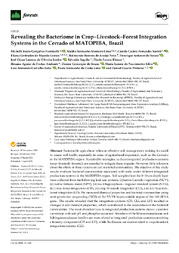Revealing the bacteriome in Crop-Livestock-Forest Integration systems in the Cerrado of MATOPIBA, Brazil.
Revealing the bacteriome in Crop-Livestock-Forest Integration systems in the Cerrado of MATOPIBA, Brazil.
Author(s): FUNNICELLI, M. I. G.; LIMA, N. S. M.; SARTINI, C. C. F.; LEMOS, E. G. de M.; ARAUJO NETO, R. B. de; SOUZA, H. A. de; OLIVEIRA JUNIOR, J. O. L. de; SAGRILO, E.; BLANCO, F. F.; ANDRADE, H. A. de F.; SOUSA, D. C. de; SILVA, M. L. do N.; LEITE, L. F. C.; LIMA, P. S. da C.; PINHEIRO, D. G.
Summary: Sustainable agriculture relies on effective soil management, making it crucial to assess soil health, especially in areas of agricultural expansion, such as the Cerrado in the MATOPIBA region. Sustainable strategies, such as integrated production systems (crop–livestock–forestry), are essential to mitigate these impacts. However, little is known about the effects of these systems on soil microbial communities. The objective of this study was to evaluate bacterial communities associated with soils under different integrated production systems in the MATOPIBA region.
Publication year: 2025
Types of publication: Journal article
Unit: Embrapa Mid-North
Observation
Some of Embrapa's publications are published as ePub files. To read them, use or download one of the following free software options to your computer or mobile device. Android: Google Play Books; IOS: iBooks; Windows and Linux: Calibre.
Access other publications
Access the Agricultural Research Database (BDPA) to consult Embrapa's full library collection and records.
Visit Embrapa Bookstore to purchase books and other publications sold by Embrapa.

